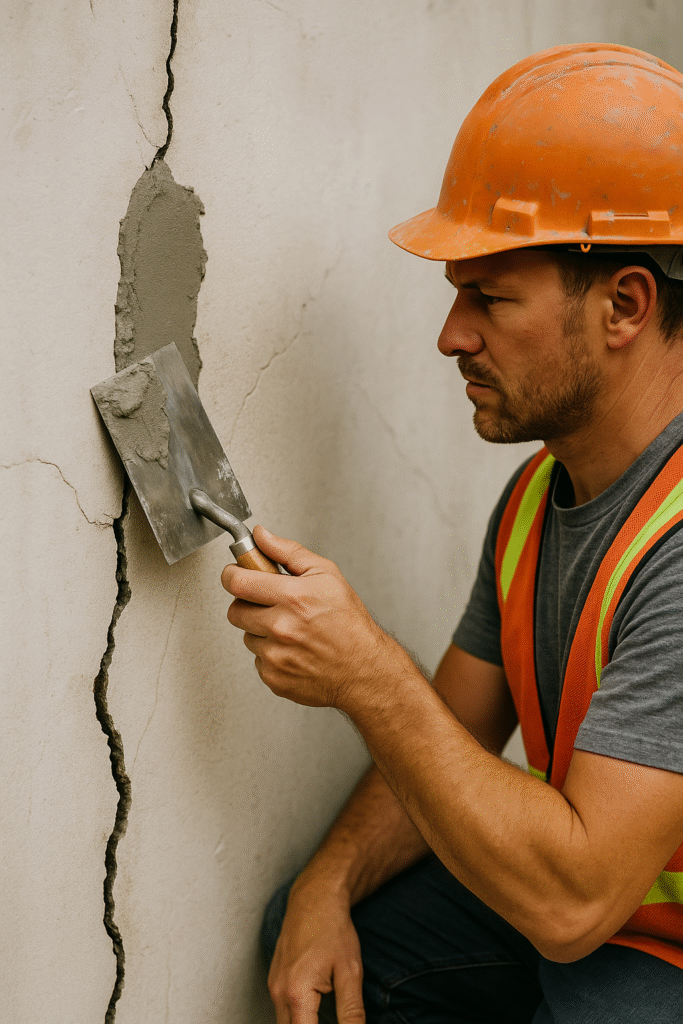For many homeowners, small cracks in the wall or floor don’t seem like a big deal. They might look harmless — just thin lines in the paint or a small split in the concrete. But over time, these little imperfections can grow into serious structural issues. What begins as a cosmetic annoyance can become a costly repair if ignored.
Whether it’s from shifting soil, seasonal temperature changes, or natural foundation settling, Crack Repair is often the first step in protecting your home’s long-term stability and safety.
Let’s break down why cracks happen, what they mean, and how professionals fix them the right way.
Why cracks appear in the first place
Homes are built to move slightly — expansion and contraction are part of how materials respond to temperature and moisture. But not all movement is harmless. Several common factors contribute to cracking:
- Soil movement: When the ground beneath a home shifts due to moisture changes, the foundation settles unevenly.
- Hydrostatic pressure: After heavy rain or snowmelt, the soil surrounding the basement walls swells, pressing water and pressure against the foundation.
- Temperature changes: Freeze–thaw cycles cause concrete to expand and contract, leading to small fissures.
- Poor drainage: Water pooling around the home can increase foundation stress and speed up cracking.
- Age and materials: Older concrete and masonry naturally weaken over decades.
While some cracks are harmless, others signal deeper structural problems that can worsen quickly.
How to tell the difference between minor and serious cracks
Not all cracks mean your foundation is failing. Some are simply surface-level issues, while others indicate deeper instability. Knowing the difference helps you decide when to call for help.
Harmless or cosmetic cracks:
- Hairline surface lines less than 1 mm wide.
- Vertical cracks in drywall that don’t widen over time.
- Small floor cracks caused by concrete shrinkage after curing.
These are usually not structural and can be sealed to prevent moisture infiltration.
Concerning or structural cracks:
- Cracks that widen or lengthen over time.
- Horizontal or step-shaped cracks along basement walls.
- Gaps wider than 3 mm or uneven on either side.
- Doors and windows that suddenly stick or misalign.
If you notice any of these signs, professional assessment is crucial. Structural cracks can allow water infiltration, reduce foundation strength, and eventually lead to basement leaks or wall shifting.
The hidden dangers of ignoring cracks
Many homeowners overlook cracks because they start small and don’t immediately cause visible damage. Unfortunately, what’s invisible today can become a major expense tomorrow.
Here’s what happens when cracks are left untreated:
- Water intrusion: Even the smallest gap can allow moisture to seep through, especially during wet seasons. This can cause basement dampness, mould growth, and a musty smell.
- Foundation weakening: Continuous water pressure widens cracks, reducing the load-bearing capacity of your walls.
- Mould and health risks: Excess moisture fosters mould spores that affect indoor air quality.
- Property devaluation: Home inspectors often flag untreated cracks during resale, leading to lower offers.
- Escalating repair costs: What could have been sealed for a few hundred dollars might later require extensive structural reinforcement.
In short, timely concrete crack restoration is not just about appearance — it’s about preventing a small flaw from becoming a major financial burden.
Common types of home cracks
Homeowners usually encounter these four main types of cracking:
1. Vertical foundation cracks
These are often caused by normal settling. They’re typically less serious but still allow water to enter.
2. Horizontal cracks
These are more serious and often result from soil or water pressure against basement walls. They can indicate that the wall is bowing or moving.
3. Diagonal cracks
Common in corners of basement windows or doors, diagonal cracks often point to uneven settling or shifting soil.
4. Floor cracks
Cracks in basement floors can form from ground pressure or improper installation. They can also allow water seepage from beneath the slab.
Understanding the pattern and direction of cracks helps professionals diagnose the cause — not just the symptom.
Professional techniques for lasting repairs
Fixing foundation cracks isn’t about covering them up; it’s about restoring the integrity of the structure and preventing future damage.
Here are the most common professional methods used:
- Epoxy injection: Ideal for structural cracks, this technique bonds the concrete back together. It restores strength and prevents further separation.
- Polyurethane injection: Used for sealing active leaks or flexible cracks. The material expands, creating a watertight barrier.
- Carbon fibre reinforcement: For horizontal or bowing walls, carbon fibre strips add strength and stability.
- Exterior waterproofing: Excavating around the foundation allows technicians to repair the wall from the outside and install membranes for protection.
- Interior sealing systems: When excavation isn’t possible, interior solutions manage water and prevent further seepage.
Each situation requires a tailored approach. That’s why getting a professional inspection before choosing a repair method is crucial.
When a crack signals something bigger
Sometimes a crack isn’t the main problem — it’s a symptom of underlying issues. Cracks accompanied by sloping floors, widening gaps, or misaligned windows may point to foundation movement.
In these cases, simply sealing the crack won’t be enough. Structural engineers might recommend reinforcement techniques such as underpinning, pier installation, or wall stabilization. The earlier these issues are detected, the simpler and more affordable the fix.
Preventing future cracks
You can’t stop natural settling, but you can minimize the stress your foundation experiences over time.
- Maintain proper grading: Make sure the soil slopes away from your home.
- Clean gutters regularly: Blocked eavestroughs allow water to pool near your foundation.
- Extend downspouts: Water should discharge at least two metres from your home.
- Inspect annually: Check both inside and outside for new cracks, especially after winter.
- Avoid heavy planting near walls: Deep-rooted trees and shrubs can disturb soil stability.
Prevention may not be exciting, but it’s the best way to protect your home investment.
How long do professional repairs last?
When done properly, fixing foundation cracks is a long-term solution. Epoxy and polyurethane injections can last 20 years or more, while structural reinforcements may provide a lifetime of stability.
The key is correct diagnosis and professional application. Quick DIY fixes often fail because they address only surface damage. Professional-grade materials bond with the concrete, ensuring the seal remains flexible yet strong.
When to call the experts
If you’re unsure whether a crack is harmless or serious, it’s always better to get a professional opinion. Trained technicians can identify whether the problem stems from surface stress, soil pressure, or drainage issues.
Companies like Dryshield Waterproofing Toronto offer detailed inspections and provide both interior and exterior repair solutions designed to address the cause, not just the appearance.
Their approach combines structural analysis with advanced sealing technology — giving homeowners peace of mind that repairs will stand the test of time.
Final thoughts
Cracks might start small, but they never fix themselves. Whether they appear in your basement walls, concrete floor, or foundation, they’re your home’s way of signalling distress.
By understanding what causes them and taking quick action, you can avoid costly damage, maintain your property value, and keep your home safe for years to come.
A small line in the wall might not seem urgent today — but every homeowner who’s dealt with major structural repair will tell you: it’s always cheaper to fix a crack early than to rebuild later.



